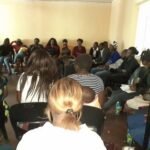NB- Views expressed in this column are solely his, and are not associated with the publication
By Aribino Nicholas
Developing a school curriculum is not like making a cup of coffee which is instantaneous, rather it is a multidimensional, multifaceted and complex process that calls for all hands to be on deck. A new curriculum should reflect a process of engagement from both distal and proximal stakeholders of the government through the Ministry of Primary and Secondary Education. Any curriculum that comes without a process of interactive justice is bound to suffer tissue rejection at the point of service delivery and also on the plane of commerce and industry. Curriculum development and implementation are not like an immunization jab, they are processes that should be dynamic, context specific, complexly intersectional, gender sensitive and pregnant enough to address the disparate needs, rights and aspirational values of a people in a society and in society. This writer has been motivated to write this opinion piece against a background of a newly introduced Heritage Based Education Curriculum 2024-2030.
The time span for the Heritage Based Education Curriculum is only six years. What has informed the introduction of this new focus? Did the government carry out any impact evaluation to enable it to gather information to necessitate the transition from the Continuous Assessment Learning Activities (CALA) to the Heritage Based Education Curriculum 2024-2030? If evaluations were made, to what extent did they take into account cross cutting issues like gender, environment, global storms like climate change, citizenship education, peace education and disability? The above questions would then help to infuse into the new curriculum a balanced educational diet for all and sundry. The introduction of CALA met with stout resistance from key stakeholders like parents and civil society organisations that have a focus on education. The government did not give a hoot about the concerns that were raised by an array of stakeholders regarding CALA. When CALA came through, learners did not have the envisaged opportunities for research and development in areas of their predilections as projects were done by teachers for a fee and in every town young people with an eye for opportunities opened offices for CALA, as they would do projects for students. CALA did not benefit students in anyway, the 30% for CALA that was to be infused into the examination profile for students was, by and large a mark coming from street smart people.
With the introduction of the Heritage Based Curriculum 2024-2030, one wonders what the success goal of the government here is because in a period of six years what is there to measure? Performance measurement of the curriculum should be bench-marked against educational life cycles; from Early Childhood Development (ECD) to Grade 7, form 1 to form 4, form 5 to form 6 and ultimately the extent to which the graduates are employable nationally, regionally and globally or the extent to which the graduates can have expanded capabilities for innovation and industrialization. The life span of this new curriculum would take a child who is in Early Childhood Development at the material time to grade six by 2030. Would this time span provide a sound national measuring scoop for the desired educational outcomes? My thinking is that a national curriculum just like a constitution is a living document that should now and again be looked at in the light of shifting political, social, economic and environmental circumstances. Still with that understanding of a living document, a curriculum should be evaluated against an educational life cycle that gives a national outlook. Developing new curricula for Africa in general and Zimbabwe in particular should afford all stakeholders to look through the window for the ideas and ideas that they cherish and for Africa in-toto, Agriculture as a compulsory subject should stand out like a diamond in a coalfield given that African economies are largely agro-based.
New curricula for Africa should also prize gender studies, peace and citizenship education right from the outset (ECD level). Africa is a continent that is awash with civil wars that are arising from intolerance based on political repression, uneven distribution of resources, tribal, regional, and religious lines. There is a need for the embracement of one another as Africans first before we identify ourselves with our countries of origin. Children should be exposed to gender studies from the level of ECD unlike a situation where students start to learn about Gender Studies in colleges or universities. Although introducing Gender Studies may be problematic for those who wield political and patriarchal power because of its capacity to challenge the existing allocations of power, resources and also its capability to question cultural norms, there is a compelling need to conscientize children right from their formative years on the importance of co-existence between and among boys and girls.
The Heritage Based Curriculum 2024-2030 should be more than a slogan for our country, it should reflect time lines that would help Zimbabwe to do an impact evaluation tied to the national values and aspirations that cover intersectional issues discussed in this opinion piece.







